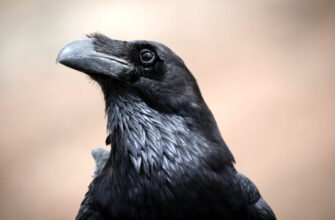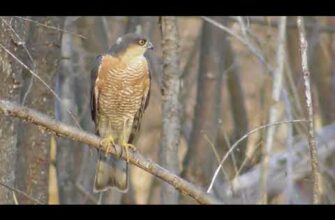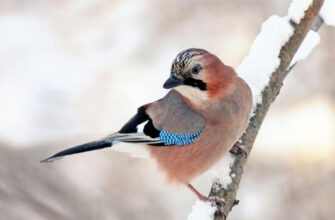Black and white magpie — this is one of the most recognizable birds, the heroine of proverbs, nursery rhymes and jokes. The bird is very common in cities, and its chirring is difficult to confuse with someone else. Also the magpie's well-known fondness for shiny objects. At the same time, she has amazing intelligence and quick wits.
Origin of the species and description
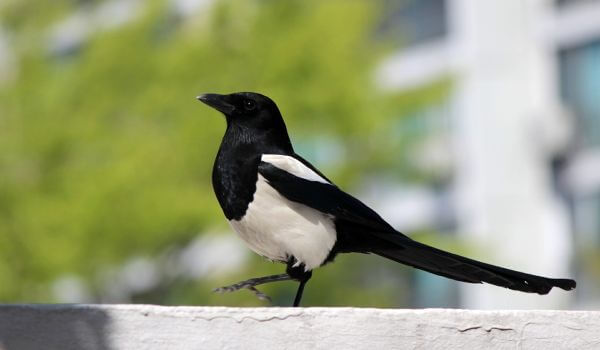
Photo: Magpie
Magpie, she is an ordinary magpie or, as it is sometimes called the European magpie & # 8212; this is a fairly well-known bird from the family of corvids of the order of passeriformes. With her name, she also gave the name to the genus forty, which also includes some exotic species that are similar to ordinary forty in body structure, but differ from them in bright and variegated colors. The Latin name for the species is Pica pica. The closest relatives of these birds are crows and jays.
The time of origin of magpies and their separation from the rest of the corvids is not known for certain. The earliest fossil finds of corvid-like birds date back to the middle Miocene and are about 17 million years old. They were found on the territory of modern France and Germany. From this we can assume that the division of the family into species occurred much later.
Video: Magpie
Now ornithologists proceed from the assumption that magpies as a species appeared on the territory of Europe, and gradually spread across Eurasia, and then in the late Pleistocene came to the territory of modern North America through the Bering Strait. However, fossils were found in Texas that are more reminiscent of the modern European magpie than the Californian subspecies, so there was a version that the common magpie could have appeared as a species already in the Pliocene, that is, about 2-5 million years ago, but in any case not earlier this time.
Today, at least 10 subspecies of magpie are known. Common magpies are distinguished by their long tail and black and white coloration.
Appearance and Features
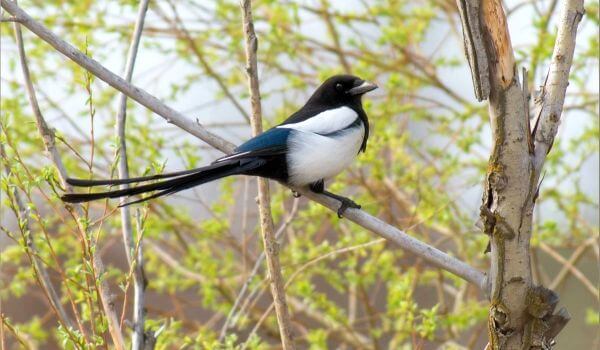
Photo: Magpie Bird
The color of the magpie is unique, and therefore it is well recognizable by many. The entire plumage is black and white. The head of the bird, its neck, back and chest and tail are black in color with a metallic, sometimes bluish bluish tint, tint and brilliance, which is especially evident in the sun's rays. At the same time, the belly, sides and shoulders of the magpie are white. Sometimes it happens that the tips of the wings turn out to be white. For their characteristic white color, magpies are often called “white-sided magpie”.
In length, magpies are up to 50 cm, but more often about 40-45 cm. The wingspan is 50-70 cm, in some cases up to 90 cm, but this is more an exception than commonplace. The tail is quite long, almost 25 cm, which is almost half the length of the entire bird, stepped and quite mobile. Females and males do not differ externally, since they have the same color and the same size.
There is still a difference, and it consists in the fact that males are slightly heavier, but this is not visually noticeable from the outside. The average male weighs about 230 grams, while the average female weighs about 200 grams. The head of the bird is quite small, the beak is slightly curved and very strong, which is typical for all corvids.
Paws of medium length, but very thin, four-toed. Forty moves on the ground with jumps and jumps, and at the same time on both paws. The tail is kept up. A gait like that of crows or pigeons is not typical for magpies. In flight, the bird prefers to glide, so the flight of the magpie looks heavy and undulating. Sometimes it is called “diving”. During its flight, the magpie spreads its wings wide and spreads its tail, so it looks very beautiful, and its shape even resembles birds of paradise.
The loud chirping of the magpie is very characteristic. Its sound is very recognizable, and therefore it is difficult to confuse it with any other bird call.
Where does the magpie live?
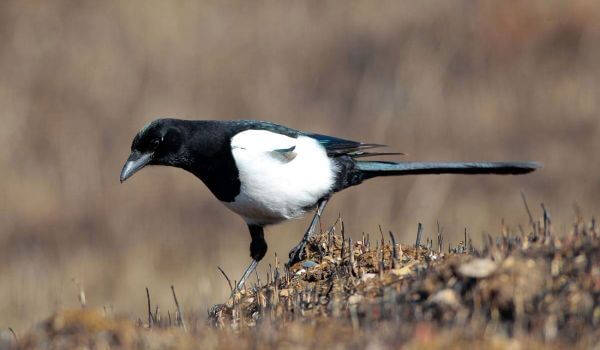
Photo: Magpie Animal
Forty habitats are mostly located on the territory of Eurasia, with the exception of its northeastern part, but at the same time there is an isolated population in Kamchatka. Magpies are settled throughout Europe from Spain and Greece to the Scandinavian Peninsula. These birds are absent only on some of the islands in the Mediterranean. In Asia, birds settle south of 65 ° north latitude, and closer to the east, the northern boundary of the habitat forty gradually recedes south to 50 ° north latitude.
To a limited extent, birds inhabit the northern, very close to Europe, parts of Africa & # 8212; mainly coastal regions of Algeria, Morocco and Tunisia. In the Western Hemisphere, magpies are found only in North America, in its western regions from Alaska to California.
Typical habitats forty — these are open spaces convenient for searching for food. But at the same time, they must be near trees or shrubs so that a large nest can be built. Very rare in large forests. The magpie can be considered a typical inhabitant of rural areas. She likes to settle in the vicinity of meadows and fields, surrounded by shrubs and forest belts. But also magpies are found in city parks and alleys, which is associated with an easier search for food in cities in winter conditions in the form of waste and food residues. Sometimes birds settle along highways or railways.
Magpies never leave their homes for a long time. Yes, sometimes they can gather in small flocks and move from a village or field to a small town for the winter to make it easier to find food, but all this happens within the same region, and the distance of movement does not exceed ten kilometers. This is too small compared to other birds that cover considerable distances with the change of seasons. Therefore, magpies are sedentary birds, not migratory.
What does a magpie eat?
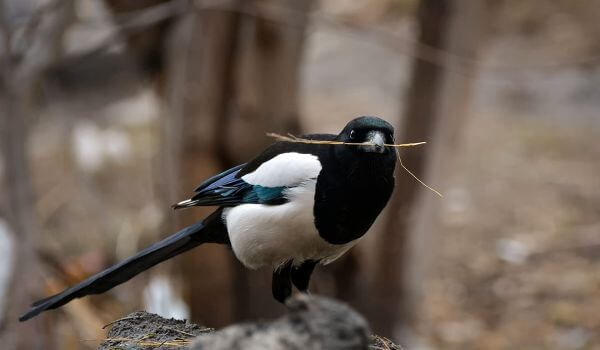
Photo: Magpie in the forest
Actually forty — it is an omnivorous bird. She can eat grains and seeds in the fields, peck at insects and parasites from the hair of grazing cattle or large wild animals, willingly eat worms, caterpillars and larvae, getting the hang of digging them out of the ground. In agricultural areas, they do not like magpies because they spoil the crop, for example, they peck at cucumbers, apples, and in the southern regions there are also watermelons and melons.
In times of famine, they do not disdain carrion and garbage in city garbage dumps. They willingly eat the contents of the feeders, including bread, nuts, grains or other plant foods left there. They can easily steal bones from dogs. But usually, other things being equal, magpies still try to eat animal food.
In addition to insects, their diet includes:
- Small rodents;
- Frogs;
- Snails;
- Small lizards;
- Chicks of other birds;
- Eggs from other people's nests.
If the size of the prey is large, then the magpie eats it in parts, breaking off pieces of meat with its powerful beak and holding the rest of the meal with their paws. Birds living in bushes or in an open field especially suffer from predatory actions of forty & # 8212; partridges, larks, quails, and some other birds into whose nests magpies climb during the nesting season to steal eggs or eat hatchlings.
An interesting fact: the magpie buries excess food in the ground as reserves in case of famine. At the same time, the intelligence of the bird allows it to quickly find its hiding place. Unlike magpies, neither squirrels nor thrifty small rodents can repeat this.
Peculiarities of character and lifestyle
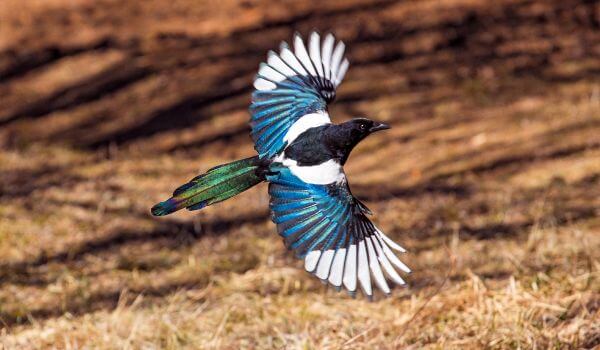
Photo: Magpie in flight
Magpies live in small flocks of 5-7 birds, less often alone. Group accommodation is very beneficial for them in terms of security. The magpie warns of the approach of enemies or any suspicious living creatures by chirping, which other birds and even animals, such as bears, have learned to understand. That is why, when hunters appear, animals often run away only when they hear the magpie. The peculiarity of magpies is that they are paired, and form pairs for life.
Two birds are always involved in nest building. The nest is laid in a spherical shape with an entrance in the side part and a clay tray adjoining it. Clay and hard branches, along with foliage, are used to build walls and roofs, and branches are specially used for the roof. The insides of the nest are lined with straw, dry grass, roots and tufts of wool. During the breeding season, several nests can be built by one pair, but in the end they choose one. Abandoned nests are then populated by other birds, such as owls, kestrels, and sometimes animals, such as squirrels or martens.
Despite the sedentary lifestyle, compared to other corvids, the magpie is a very mobile and active bird. It is characterized by diurnal movements. She rarely stops for a long time in one place and constantly jumps from one branch to another, flies over long distances, searches bushes and trees in search of other people's nests and food. Leads a purely daytime lifestyle.
Magpie has a good memory, and among all birds is considered one of the most intelligent. Although she is very curious, she is also very circumspect and able to avoid traps. The bird is easily trained, masters new skills and quickly adapts to a changing environment. Zoologists have also found elaborate sequences and social rituals in magpies.
There are suggestions that magpies even know the expression of sadness. It is well known that these birds are not indifferent to shiny objects, which they continually steal from people or pick up on the roads. Interestingly, thefts never happen in the open, and before stealing an object, the birds always first make sure that nothing threatens them.
An interesting fact: today forty — it is the only bird that can recognize itself in a mirror and not think that another individual is in front of it.
Social Structure and Reproduction
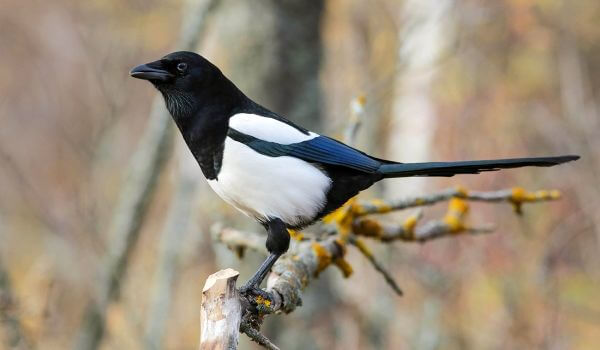
Photo: Magpie on a branch
Magpies are distinguished by the fact that they are often devoted to their chosen one. They choose their companion in the first year of life. For them, this is a responsible decision, because it is in pairs that they will build a nest and feed their chicks for all subsequent years.
In spring, magpies choose a secluded place for themselves in a bush or high in a tree. If there are houses inhabited by people nearby, then magpies choose a place for a nest as high as possible, fearing encroachment. Magpies begin to mate with a partner only in the second year of life.
Magpies usually lay about seven or eight eggs. Egg laying occurs in mid-April. Their eggs are light blue-green in color with speckles, medium in size up to 4 cm in length. The female is incubating the eggs. For 18 days, she warms future chicks with her warmth. Chicks are born naked and blind. After hatching, the parents share caregiving responsibilities equally. That is, both the female and the male take care of the chicks. They spend all their time looking for and delivering food to their offspring.
This continues for about a month, and on about the 25th day, the chicks begin to try to fly out of the nest. But attempts to fly solo do not mean that they will start independent life so quickly. They stay with their parents until autumn, and sometimes it happens for a whole year. For a long time they intercept food from their parents, although physically they are already quite able to get it themselves.
It happens that in magpies nests are destroyed by predators. In such cases, magpies can build a nest again or complete someone's abandoned one, and then lay their eggs again. But they will do it more quickly. Whole groups of magpies are sometimes observed laying eggs in June. Probably for some reason their previous spring attempt to breed was not successful.
Natural enemies of magpies
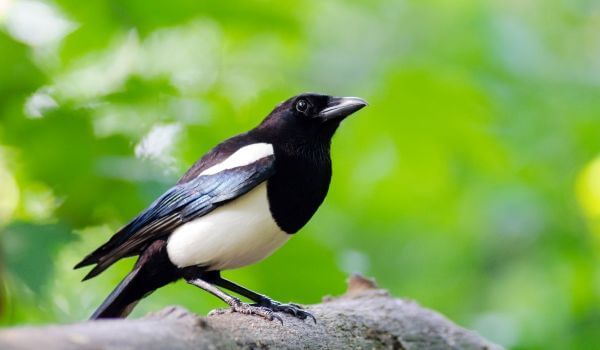
Photo: Magpie in nature
In the wild among the enemies are forty mostly large species of birds of prey:
- Falcons;
- Owls;
- Owls;
- Eagles;
- Eagles;
- Hawks;
- Owls.
Magpie chicks living in tropical regions sometimes also suffer from snake attacks. In our latitudes, a squirrel, hazel dormouse or marten can climb into a bird's nest. Moreover, if the last two animals eat chicks and eggs, then the squirrel may not even feast on the eggs of a bird or its chicks, but simply throw them out of the nest.
And this also leads to their death. Adult birds are too large for such animals. But among larger mammals, adult magpies are often attacked by wild cats. Sometimes birds become prey for foxes and, in very rare cases, wolves or bears. The magpie is very cautious, and therefore comes across very rarely, and the victims are mostly sick or very old birds.
A man today has turned from an enemy of the magpie into something neutral. Yes, sometimes nests are destroyed or magpies are exterminated as pests, but this occurs in very rare cases, and ingenuity and caution help magpies to escape. At the same time, thanks to man, birds have the opportunity to constantly find food in landfills.
Population and species status
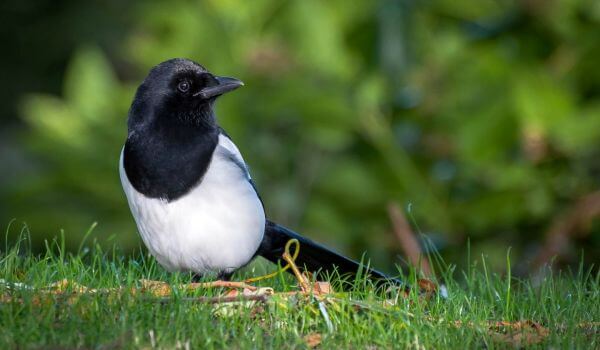
Photo: Magpie bird
Magpies are not endangered species, and unlike many other birds, they are not at all threatened with extinction. Their population is very stable. Today, the total number of ordinary forty is about 12 million pairs.
Even though in many countries and regions people even deliberately exterminate magpies because they consider them pests, the average number of these birds is not decreasing. Moreover, in some regions, there is even a periodic increase in their numbers in different years up to 5%.
The sustainable existence of these birds is facilitated by omnivorousness and the ability to find food in winter conditions in places where people live. The main increase in the population of magpies is in cities, where they occupy more and more territories. The average population density of magpies in cities is about 20 pairs per square kilometer.
The caution of these birds, their high intelligence and ingenuity, as well as the fact that both parents take care of the offspring, play an important role. Forty nests are located high, covered with a roof from above, so even for birds of prey they are difficult to access. Healthy magpies are very rarely caught by predators, so if the bird has reached adulthood, then we can assume that the magpie has already ensured its safety.

